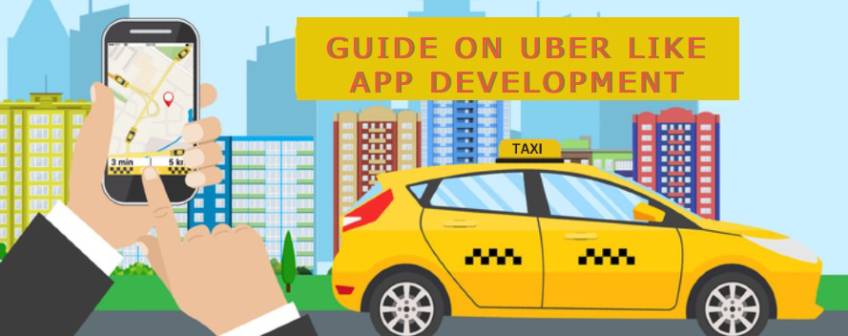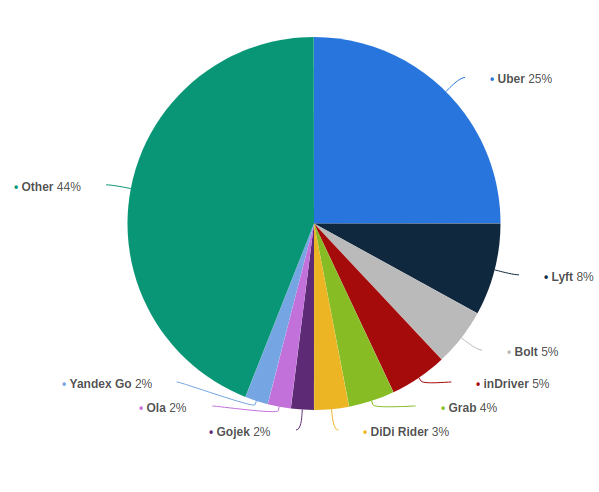
Guide on Uber like app development: What all you need to know?
Are you contemplating diving into the lucrative world of on-demand app services? Developing an Uber-like app can be an exciting yet challenging journey. In this comprehensive guide, we will walk you through everything you need to know about creating an app that could stand shoulder-to-shoulder with giants like Uber. From initial market research to software development, and navigating legal regulations to launching and scaling your application, each step is crucial for success.
We'll explore the key features that an effective ride-sharing app must have, the technologies that can power your platform, and the business strategies that could propel your app to the forefront of the market. Whether you're a budding entrepreneur, a seasoned developer, or somewhere in between, this guide will provide you with valuable insights and practical advice to help you embark on this rewarding entrepreneurial journey. Let's get started on transforming your innovative app idea into reality!
Embarking on Uber-like app development involves navigating through various challenges and considerations. This blog serves as a comprehensive guide, offering valuable insights into the essential steps and factors to consider when developing an app similar to Uber. From market research to choosing the right technology stack, explore the key elements that contribute to the success of Uber-like app development. Learn about the crucial features, design considerations, and user experience aspects that play a pivotal role in creating a competitive and user-friendly app.
Key Insights into Developing a Ride-Sharing App Similar to Uber

Before we delve deeper into the topic, it's crucial to recognize Uber's massive scale. By the end of 2020's fourth quarter, Uber had amassed a global user base of 93 million monthly active users, marking a significant 19-fold increase from the previous quarter. In the ridesharing arena, Lyft also plays a significant role but trails behind Uber, which commanded 70% of the market in 2020, with Lyft holding the remaining 30%.
Uber's dominance in the market can be attributed to its effective app-user interface, robust marketing strategies, and a notably low rate of error reports. The Uber app, available on both Android and iOS platforms, seamlessly connects riders with drivers 24/7, every day of the year, across more than 800 cities in 84 countries. With real-time location sharing, neither drivers nor riders need to worry about coordinating arrival times anymore.
How to Develop an app like Uber?
Developing an app similar to Uber involves several important steps and considerations. Here’s a comprehensive guide on what you need to know to create a ride-sharing app:
1. Research and Conceptualization
- Market Research: Understand the existing market, competitors, target audience, and local regulations. Identify gaps in the current offerings where your app could excel.
- Unique Value Proposition: Define what makes your app different and better. This could be anything from lower fares, better service, additional safety features, or a niche like pet-friendly rides.
2. Business Model
- Revenue Model: Consider how your app will generate revenue. Common models include taking a percentage of drivers' earnings, charging riders a booking fee, or offering premium services.
- Service Model: Decide whether you want to operate globally, regionally, or locally. Also, choose the types of services you will offer, such as carpooling, luxury rides, or deliveries.
3. Legal Considerations
- Licensing and Permits: Depending on your location, you may need specific licenses to operate a transportation service.
- Insurance: Ensure both drivers and riders are covered under all necessary insurance policies.
- Compliance with Local Laws: Be aware of local transportation laws and regulations, including those related to employment and data privacy.
4. App Features
- Core Features for Riders: App features should include ride booking, fare estimation, driver tracking, payment integration, rating and feedback, and customer support.
- Core Features for Drivers: Driver features might include trip management, earnings tracker, route optimization, and support.
- Safety Features: Options such as real-time tracking, SOS buttons, and driver background checks are crucial for user trust and safety.
- Advanced Features: Consider implementing features like split payments, multiple destinations, schedule rides, or accessibility options.
5. UI/UX Design
- User-Centric Design: Focus on creating an intuitive and accessible interface.
- Brand Identity: Consistent and appealing visual design that represents your brand across all screens.
6. Development and Testing
- Agile Methodology: Develop in phases with continuous testing and feedback loops.
- Quality Assurance: Conduct thorough testing, including functional testing, usability testing, performance testing, and security audits.
- Beta Testing: Release a beta version to a controlled group of users to collect real-world usability feedback.
7. Launch and Marketing
- Soft Launch: Start in a smaller market to refine the app based on user feedback.
- Marketing Strategies: Utilize social media, content marketing, PR campaigns, and promotions to attract users.
- Analytics: Implement tools to track usage, retention, and other important metrics to optimize performance post-launch.
8. Post-Launch Management
- Customer Support: Provide robust support to deal with user queries and issues effectively.
- Updates and Maintenance: Regularly update the app with new features, security enhancements, and performance improvements.
- Scalability: Prepare your infrastructure to scale up as your user base grows.
Creating an app like Uber is a complex but feasible project that requires detailed planning, a strong understanding of legal requirements, and solid execution. Hiring experienced developers, or consulting with a development company that has expertise in creating similar apps, can significantly increase the chances of success.
Factors that determine the cost of an Uber like app?
Developing an app like Uber involves numerous components, each contributing to the overall cost. The cost can vary widely based on the scope of the project, the technologies used, the features included, and the regions targeted. Here are the primary factors that determine the cost of developing an Uber-like app:
1. Platform and Technology Choices
- Mobile Platforms: Whether the app is developed for iOS, Android, or both can impact the cost due to different development requirements and complexities.
- Tech Stack: The selection of technologies for backend development, database management, front-end, and cloud services can affect the cost. Using advanced and scalable technologies might increase the initial cost but could save money in the long term by reducing maintenance costs.
2. Feature Complexity
- Basic Features: Including essential features like booking, GPS tracking, payment integration, and basic user interfaces comes with standard costs.
- Advanced Features: Adding real-time analytics, in-app wallets, AI-based suggestions, or other sophisticated features can significantly increase the cost.
- Customization: Tailoring the user experience and functionalities to meet specific business needs or regulatory requirements can also add to the development expenses.
3. UI/UX Design
- Design Complexity: The intricacy of the app’s design, including custom animations, high-fidelity graphics, and user experience design, can raise the cost.
- Branding: Customizing the app to align with specific branding guidelines involves additional design work, thus affecting the price.
4. App Development Team
- Location: The geographic location of the development team significantly influences cost. Developers in North America and Western Europe typically charge more than those in Eastern Europe or Asia.
- Expertise: Highly skilled and experienced developers or agencies may command higher fees, but also bring added value through higher quality work and potentially faster delivery.
5. Integration of Third-party Services
- APIs: Costs are incurred when integrating third-party APIs for mapping (Google Maps API), payment gateways (Stripe, PayPal), SMS notifications (Twilio), etc.
- Custom Integrations: More bespoke integrations or the need to develop proprietary APIs can increase development costs.
6. Testing and Quality Assurance
- Extent of Testing: Comprehensive testing, including functional testing, security audits, and performance testing, is crucial but can be costly.
- Continuous Updates: Implementing continuous integration and delivery pipelines to manage and automate testing and deployment processes can add to the upfront cost.
7. Legal and Administrative Costs
- Compliance and Licensing: Meeting legal requirements, acquiring necessary licenses, and ensuring compliance with local regulations, such as data protection laws, can incur additional costs.
- Insurance: Securing insurance for operational liabilities also adds to the financial burden.
8. Marketing and Launch
- Pre-launch Marketing: Costs associated with promoting the app before its launch through various channels.
- Launch Operations: Expenses related to the launch event, initial customer support setup, and other operational needs.
9. Maintenance and Scaling
- Ongoing Support: Post-launch support and maintenance to ensure smooth operation include server costs, bug fixing, and updates.
- Scalability: Planning for future growth from the start can involve investments in scalable architecture and cloud services, impacting initial costs but potentially saving money as the user base grows.
Estimating the cost of developing an app like Uber requires a detailed understanding of these factors and their implications for your specific project. By carefully planning and budgeting for these aspects, you can ensure a successful launch and operation of your ride-sharing service.
Essential Uber-like features
Developing an app like Uber is a complex and time-consuming process, requiring careful planning, execution, and ongoing management. Success in the ride-sharing industry requires not just a functional and user-friendly app, but also a strong business model, effective marketing, and a commitment to continuous improvement and customer satisfaction. Here are features of Uber Clone App as per given below:
Passenger app
The Passenger App is a pivotal component of ride-sharing services, designed to provide users with a seamless and intuitive interface for booking rides, tracking drivers, managing payments, and reviewing their journey experiences. It's the direct point of interaction between the service and the passengers, making its usability, reliability, and efficiency crucial for ensuring customer satisfaction and loyalty. Here are some important features as per given below:
1. Chat Feature using Sockets: The application incorporates a socket-based chat mechanism, enabling seamless and swift communication between riders and drivers directly within the app.
2. Vehicle Categories: The platform is designed with exceptional flexibility, allowing real-time control of categories directly from the admin panel. This enables administrators to add, edit, or remove categories, adjust pricing, and modify additional settings without downtime.
3. OTP On Trip Start: To enhance rider security and prevent fare manipulation, we implemented a feature requiring riders to provide a One-Time Password (OTP) before the driver can commence the ride. This measure was introduced in response to instances where drivers initiated rides prior to picking up the rider, leading to unfair fare increases. By mandating an OTP from the rider, we aim to deter fraudulent activities, ensuring a safer and more trustworthy experience for all users.
4. Outstation: The platform now includes an outstation booking feature, enabling riders to reserve rides for long distances. Furthermore, this option allows for the booking of outstation trips for a variable number of days, tailored to the specific needs of the rider.
5. Live Tracking: The taxi app incorporates real-time tracking of the driver's location during the ride. An added feature allows the admin to monitor all drivers on a map, enhancing operational oversight. Additionally, riders have the option to share their ride details with family and friends, who can then track the rider's location on the map for increased safety and peace of mind.
6. Rentals: The taxi app also offers a rentals feature, alongside the immediate ride option. Rentals function as predefined packages, where prices are set for specific distances and durations. For instance, a package offering 4 hours and 40 kilometers is priced at $120. This addition provides riders with greater flexibility, allowing them to select packages that best fit their requirements.
Driver app
The Driver App is a critical component of ride-sharing platforms, designed to facilitate drivers with the tools they need for efficient operation, communication, and navigation. This app serves as the backbone for drivers, enabling them to accept ride requests, navigate to the passenger's location, manage their earnings, and communicate with passengers. Here's a breakdown of key features typically found in a driver app:
Multi-language: The admin panel enables complete management of app localizations. This means, for instance, that clients have the ability to incorporate multiple languages into the taxi app and oversee the translations within the admin panel.
Driver Statistics: Prior to determining the optimal method for displaying statistics, we conducted an extensive analysis on client data. This research has enabled us to provide drivers and administrators with comprehensive insights for improved planning. Drivers now have access to detailed performance metrics, including daily and monthly overviews, as well as in-depth statistics covering completed rides, rejections, and missed opportunities.
In-app Turn-by-turn Navigation: Our app distinguishes itself from competitors with its in-app turn-by-turn navigation feature, achieving unparalleled accuracy in map navigation and providing seamless, in-app turn-by-turn directions. This eliminates the need for drivers to switch between our app and external navigation apps like Google Maps or Waze. We are currently developing voice instruction capabilities to enhance this feature further.
Smart Referrals & Rewards: The development of this feature was informed by surveys conducted with over 100 live clients, ensuring it meets real-world needs effectively. Additionally, we have focused on making the system robust in terms of implementation.
Smart Fare Management System: In response to the diverse needs of our clientele, we've designed a fare management system that's both flexible and dynamic, allowing for comprehensive adjustments and control directly from the taxi app's admin panel. Additionally, we've prioritized transparency in fare calculation by displaying it in real-time on the driver's application screen throughout the ride. This ensures a clear and trustworthy process for both drivers and passengers, enhancing the overall experience.
Driver Documents: As per every country's varying requirements and laws, we have made it configurable to add or change the documents required for the drivers to sign up on the platform. So clients need to be reassured about the changing laws in the future.
Admin Panel
The Admin Panel serves as the control center for ride-sharing platforms, providing administrators with comprehensive tools to manage both the rider and driver experiences, monitor operations, and make data-driven decisions. This web-based dashboard is crucial for maintaining the smooth functioning of the service, overseeing user activity, resolving disputes, and enhancing overall service quality. Key features of an Admin Panel include:
Drivers Manager: The admin panel is empowered to comprehensively manage driver access on the platform. This includes the ability to verify or block drivers, request additional documents, monitor their performance, review their wallet status, examine documents, oversee referrals, and much more. We've designed the admin role to act as a superpower, granting them full control over operational aspects in real-time.
Users Manager: Similarly, the driver manager is granted full authority over the rider's access to the platform. This role encompasses the ability to manage or observe their booked, canceled, and completed rides, as well as to resolve any issues or grievances directly from the panel.
Transactions Manager: The admin has the capability to monitor all transactions occurring on the platform. Additionally, they can delve into the specifics of each transaction, including taxes, commission, payment methods, wallet transfers, and more, ensuring a comprehensive understanding of the platform's financial flows.
Wallet Manager: The foundational advantage of our platform lies in its integrated wallet system, setting us apart from competitors. Once comprehended, it becomes evident that such a system is essential for business operations. This feature not only aids in retaining both riders and drivers by enhancing their engagement with the platform, but it also enables the company to maintain a higher level of funds, fostering a more robust economic ecosystem within the platform.
Trips/Rides Manager: The admin has the capability to monitor rides in real-time, including those that are ongoing, completed, canceled, missed, or rejected by drivers. Furthermore, the admin possesses the authority to dispatch rides directly from the admin panel and manually assign drivers to booked rides, offering a high level of operational control and flexibility in managing ride allocations.
Reports: The admin is provided with access to a wide range of reports, enabling them to effectively plan and strategize various activities aimed at supporting and expanding the business. These reports offer valuable insights into operations, financial performance, user engagement, and more, serving as a critical tool for informed decision-making and strategic development.
Conclusion
Developing an Uber like app is a dynamic and multifaceted endeavor that can set the stage for substantial business success in the rapidly growing ride-sharing market. At our company, we leverage deep industry expertise and cutting-edge technology to help clients navigate every step of the app development process. From thorough market research and strategic planning to high-quality implementation and continuous support, we ensure that your ride-sharing app not only meets but exceeds the expectations of modern consumers. Partnering with us means embarking on a journey to create a seamless, efficient, and user-friendly service that stands out in today's competitive landscape. Let's transform your visionary idea into a reality, empowering your business to accelerate forward in the world of transportation.
Looking out to start your own venture like Bolt? Try out our HireMe Taxi Uber Clone, the easiest way to kick-start your taxi business.





